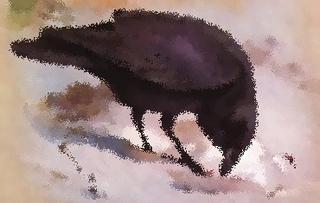Ancient & Modern Ravens

Lately there has been a proliferation of local ravens, with the coming of Spring and the nesting season. Many of these beautiful birds have come gathering lately, allowing themselves to be seen at close range. This is a real treat; they are gentle and very alert, contrary to common superstition. They mate for life and the large raven, found in the southern hemisphere, can live up to fifty years of age. The oldest known raven was sixty-nine.
Part of the Corvid species, they are the largest, and their constellation lies directly above in the heavens at the moment, and is called "Corvus". Before their ecological link was properly known, they were persecuted in England and Europe, almost to the point of non-existence. Once the public were educated, the culling stopped, and the corvids were welcomed back again, to breed again. They are considered nature's tidier, sorter, and order keeper, and this is their ecological purpose.
When Corvids fly, they do so at a measured single-minded pace, in a steady line. This is where the saying "As the Crow Flies" comes from; it means to go in a straight line. When nesting, both birds build a solid twiggy home, and the male feeds the female while she nests. Both sexes feed the young, flying out searching for food, and often any excess is buried for later. They are intelligent and have a connection with Wisdom lore and tales of all cultures.
Gregarious by nature these birds can be trained to count and to interpret and mimic human speech. A caged Raven was once helped to escape by two wild Ravens who dug a hole into its cage from the outside while the caged bird dug out from the inside. Ravens have been much maligned by man in the past, though modern research has shown that they, like crows, do far more good than harm. Mostly this was due to projected superstition and lack of knowledge, and now there is more education on this species in general, there is also far more respect.
They were included with other animals in the ancient cave paintings at Lascaux near the French Pyrenees, and have had a long association with man. Historically they occupy space at the top of the Tower of London, and it is said that if fewer than six are present, the consequences are dire, so are welcome in the city streets and squares for the important work they do.
(http://www.earthlife.net/birds/crows.html)


 The
The 
6 Comments:
What a magnificent tribute to our constant companion on this journey. Just call and one will fly to you from the rookery to do your bidding.
Of course, they are beauties I am seeing every day! Off to see your post Faucon...
A few are just flying up now...wonders they are...
Here I am having to round the mountains on a donkey when I might just need to speak to the crow atop the gum tree and fly straight to the cave! (Heather is giving us pilgrims a lot of trouble (:-)
It is not me that is problematic Fran. It is that ruddy Enchantress who is up to old tricks. :-) Be kind to the old donkey that has your name on her back.
Don't ignore the donkey path - it teaches so much about this beloved carrier of people. I love donkeys and might do a story on them too. In biblical times it was considered a mark of greatness that a Messiah would ride on a donkey - this meant he was in touch with the people and would not sell out to ego - that was two thousand years ago. Donkey or raven, valuable lessons to learn. You'll be glad you did, Fran!!! Trust me!
Post a Comment
<< Home